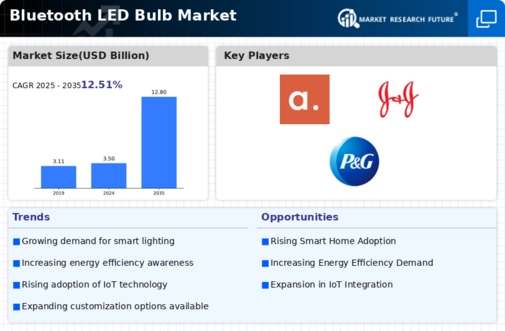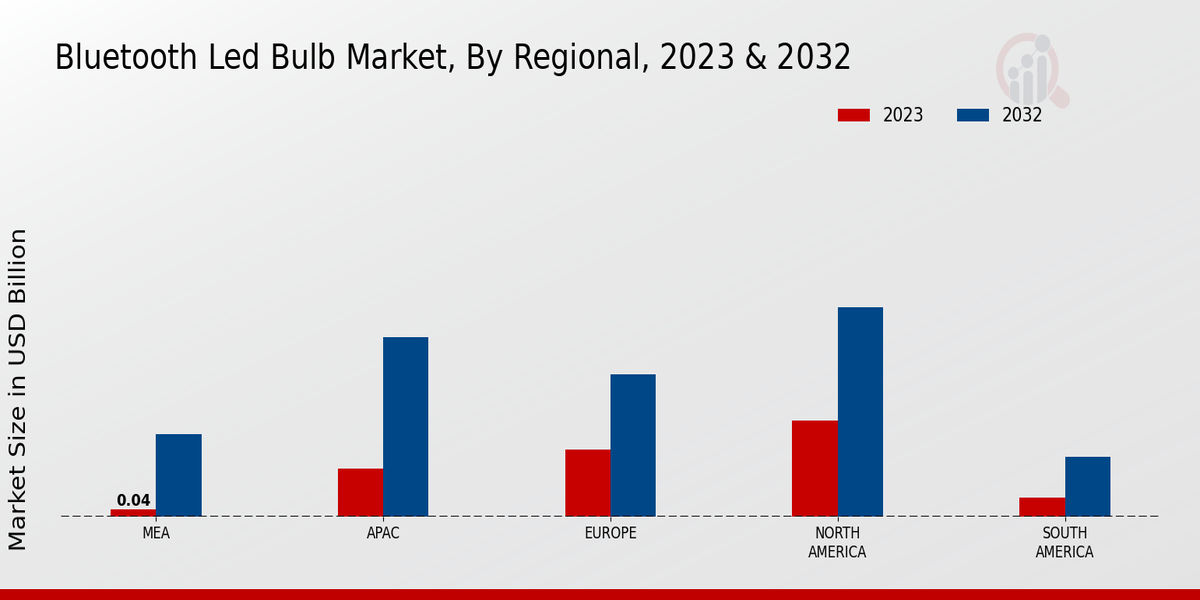Market Growth Projections
The Global Bluetooth LED Bulb Market Industry is projected to experience substantial growth over the next decade. With a market value anticipated to reach 3.5 USD Billion in 2024 and 12.8 USD Billion by 2035, the industry is poised for a remarkable transformation. The expected CAGR of 12.51% from 2025 to 2035 indicates a strong upward trajectory, driven by factors such as technological advancements, increasing consumer demand for smart home solutions, and a growing emphasis on energy efficiency. These projections suggest a dynamic market landscape, where innovation and consumer preferences will shape the future of lighting solutions.
Consumer Awareness and Education
Consumer awareness and education regarding the benefits of Bluetooth LED bulbs are vital for the Global Bluetooth LED Bulb Market Industry. As consumers become more informed about energy savings, convenience, and the environmental advantages of LED technology, they are more likely to adopt these products. Educational campaigns by manufacturers and governments can further enhance understanding and acceptance of Bluetooth-enabled lighting solutions. This increased awareness is expected to drive market growth, as consumers seek to make informed choices that align with their lifestyle preferences and sustainability goals.
Energy Efficiency and Sustainability
The Global Bluetooth LED Bulb Market Industry benefits from a growing emphasis on energy efficiency and sustainability. LED technology, known for its low energy consumption and long lifespan, aligns with global efforts to reduce carbon footprints. Governments worldwide are implementing regulations and incentives to promote energy-efficient products, further propelling the adoption of Bluetooth LED bulbs. As consumers become more environmentally conscious, the demand for sustainable lighting solutions is expected to rise. This shift could lead to a market valuation of 12.8 USD Billion by 2035, highlighting the importance of eco-friendly innovations in the lighting sector.
Technological Advancements in Lighting
Technological advancements play a crucial role in shaping the Global Bluetooth LED Bulb Market Industry. Innovations in Bluetooth technology enhance connectivity and user experience, allowing for more sophisticated control features such as dimming, color changing, and scheduling. These advancements not only improve functionality but also attract tech-savvy consumers looking for customizable lighting solutions. The anticipated compound annual growth rate (CAGR) of 12.51% from 2025 to 2035 suggests that the market will continue to evolve, driven by ongoing research and development efforts aimed at enhancing product performance and user engagement.
Growing Demand for Smart Home Solutions
The increasing consumer preference for smart home technologies drives the Global Bluetooth LED Bulb Market Industry. As households seek to enhance convenience and energy efficiency, Bluetooth LED bulbs emerge as a popular choice. These bulbs allow users to control lighting through smartphones or smart assistants, integrating seamlessly into existing smart home ecosystems. The market is projected to reach 3.5 USD Billion in 2024, reflecting a robust demand for innovative lighting solutions. This trend indicates a shift towards automation and connectivity, suggesting that consumers are increasingly valuing the ability to manage their home environments remotely.
Rising Urbanization and Infrastructure Development
Urbanization and infrastructure development significantly impact the Global Bluetooth LED Bulb Market Industry. As urban populations grow, the demand for efficient lighting solutions in residential, commercial, and public spaces increases. Bluetooth LED bulbs are particularly appealing for urban environments due to their ease of installation and integration into smart city initiatives. This trend is likely to contribute to the market's expansion, as cities invest in modern lighting systems that enhance safety and energy efficiency. The combination of urban growth and technological integration positions Bluetooth LED bulbs as a key component in future urban planning.





